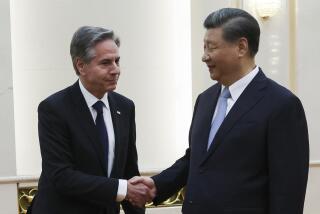Can Trust Spring From Aerial Danger?
- Share via
The collision of a U.S. Navy electronic surveillance aircraft with a Chinese jet fighter has created a very delicate--and potentially dangerous--situation. If not handled correctly by both sides, this incident could deteriorate significantly in the days ahead and seriously damage an already precarious China-U.S. relationship. If handled properly, however, the incident arguably could increase the current meager level of trust existing on both sides and lower tensions overall. As of this writing, the cooler heads appear to be in control.
The collision apparently resulted from an accidental bumping during what has become an increasingly perilous cat-and-mouse interaction between U.S. and Chinese aircraft operating along China’s maritime border, in which the Chinese have become progressively more assertive. Similar incidents could happen between many countries and likely would be resolved according to clearly defined international procedures without major damage to relations. In this case, however, as with the larger China-U.S. relationship, thoughts and actions are increasingly colored by growing mutual distrust and misperceptions regarding the capabilities and intentions of the other side.
During the past several years, many Chinese have been shocked by what they regard as an increasingly aggressive U.S. global stance (as exemplified by its non-U.N.-backed assault in Kosovo), angered by what they regard as the deliberate bombing of the Chinese Embassy in Belgrade by U.S. warplanes and concerned by increasingly strident U.S. calls for a more coercive approach to handling everything from Taiwan to human rights issues. Such views place considerable pressure on the Chinese government when handling incidents of alleged U.S. “aggression” (as the current incident is being portrayed among some members of the Chinese public). In other words, this incident is regarded by some as a U.S. “test” of Chinese resolve.
Similarly, many Americans increasingly view China as a belligerent power that poses a growing strategic threat to U.S. interests, increasingly seeks to militarily coerce democratic Taiwan and harasses and represses not only its own citizens but, most recently, U.S. citizens traveling in China. For these people, China’s behavior during the current incident--especially the speed with which it cast the U.S. as the guilty party and the slowness with which it responded to U.S. inquiries--confirms the Chinese tendency to bully and coerce.
Hard-liners on both sides could thus strengthen their argument for a more defiant approach toward the other side. And that, in turn, could boost the chance that sensitive issues--including the sale of Aegis radar systems to Taiwan--will be mishandled, adding more fuel to the fire and producing an otherwise avoidable crisis for the new Bush administration.
That outcome is by no means inevitable, however. If both sides drop their premature assessment of blame, avert further provocation by eschewing any type of military deployments in the area, maintain direct, authoritative, real-time communications and attempt to proceed on the basis of international practices, a level of trust could be created that would bode well for subsequent interactions. In particular, a forthright, cooperative Chinese approach that resulted in a reasonably prompt return of the crew and its aircraft could significantly undermine the position of those on both sides who assume the worst and thus increase the chances that the pending U.S. arms sale to Taiwan will not result in a further downward spiral.
More to Read
Sign up for Essential California
The most important California stories and recommendations in your inbox every morning.
You may occasionally receive promotional content from the Los Angeles Times.










